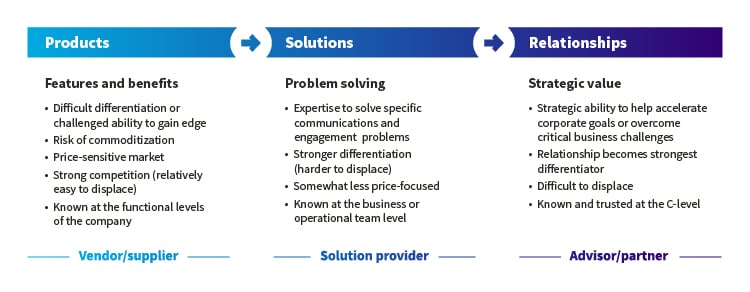Don’t want your solutions commoditized? Don’t commoditize your customers.
March 27, 2017
By Rod Griffith
October 8, 2021

Relationship selling isn’t just about having a friendly demeanor with your customer—though that’s quite important. In relationship selling, the seller goes from just providing a product or service to becoming a strategic partner. The advantage being that, once you achieve that relationship, it is very difficult for the competition to knock you out.
In this article, we’ll contrast relationship selling to more traditional selling models and explore why some organizations struggle to achieve it.
When you think of marketing, it’s most likely in the context of promoting a product or service—all the things that precede a sale. In the B2C world, it’s often about targeting the largest consumer base that might buy your product. But in B2B marketing, the challenge is much more focused: You need to get the right business message in front of the right decision maker.
The role of that decision maker—whether a shop-floor supervisor, middle manager, or CTO—determines the selling strategy that is required. These strategies can be divided into three tiers: product selling, solution selling, and relationship selling.

In technology marketing, some businesses get themselves stuck between product selling and solution selling, mostly out of habit. After years (or decades) of developing a product and honing it to perfection, they know every bit and byte of it inside out and can recite technical specs backward and forward.
This knowledge creeps into their marketing message because it excites them. They can recite numerous use cases where their product has benefited other customers instead of focusing on the benefits it would bring for the customer at hand.
That’s the trap. By focusing on the smaller picture—bits and bytes—they fail to establish themselves as the most reliable, trustworthy, future-looking expert in their own field. And, without that footing, they can’t launch themselves into the relationship-selling space.
In recent years, we’ve seen many cloud technology providers move toward relationship sales arrangements with their customers. Fueled largely by the as-a-service (aaS) movement, these providers can offer their customers a broad category of cloud computing and networking services on demand. This allows those customers to run their workloads and reap the benefits of the latest networking technology without having to own, operate, and maintain their own data center.
The technology providers offer oversight by making sure their customers aren’t over-allocated or paying for more resources than they require. As newer, faster technologies develop, customers no longer have to upgrade their infrastructure because this is all done by the cloud provider.
Customers trust the provider to run the backend of their business, monitor usage, control costs, and make suggestions about how they could operate more profitably. They’re not just delivering a service; they are proactively looking out for their customers because that is their relationship. Eventually we may see this relationship service model trickle into the B2C space for cellular phone, internet, cable television, and other subscription services.
This article has focused on the macro view of relationship selling, but it’s important to understand that establishing that level of business relationship only comes from many years of developing interpersonal relationships. A solution provider earns trust by delivering exceptional service consistently and always going above and beyond for their customers. They have to be reliable and gradually integrate themselves into the customer work culture so that the transition from solution provider to relationship provider is seamless, comfortable, and mutually beneficial.
Like all relationships, they can get sticky at times when strong personalities clash. At these times, you’d be wise to focus on your long-term business goals and remember the old adage: The customer is always right.
We take pride in a team loaded with smarts, wit, and ideas. If you'd like to have a smarter, wittier inbox filled with ideas each month, subscribe here to the MarketReach Blog, and we will let you know when there is something new you might like!

Need us now? Just want to learn more? We’d love to talk.